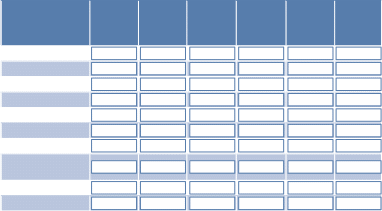Form 1122-0009 Semi Annual Progress Report for Supervised Visitation Pr
Semi-annual Progress Report for Safe Havens: Supervised Visitation and Safe Exchange Grant Program
SafeHavensFormGMSSample2014
Semi-annual Progress Report for Safe Havens: Supervised Visitation and Safe Exchange Grant Program
OMB: 1122-0009
THIS
IS
A
SAMPLE
GMS
FORM.
DO
NOT
USE
THIS
FORM
TO
SUBMIT
YOUR
FINAL
DATA
TO
OVW.
OMB Clearance # 1122-0009 Expiration Date: 08/30/2014
U.S. Department of Justice Office on Violence Against Women
SEMI-ANNUAL PROGRESS REPORT FOR
 Safe
Havens:
Supervised
Visitation
and
Safe
Havens:
Supervised
Visitation
and
 Safe
Exchange
Grant
Program
Safe
Exchange
Grant
Program
Brief Instructions: This form must be completed for each Safe Havens: Supervised Visitation and Safe Ex- change Grant Program (Supervised Visitation Program) grant received. The grant administrator or coordinator must ensure that the form is completed fully with regard to all grant activities. If the program involves more than one site (either for provision of services or for planning), there will still be only one form completed for each program. Grant partners, however, may complete sections relevant to their portion of the grant. Grant administrators or coordinators are responsible for compiling and submitting a single report that reflects all information collected from grant partners.
All grantees should read each section to determine which items they must answer, based on the activities engaged in under this grant during the current reporting period. Sections A1, B, C2, C3, E, and F of this form must be completed by all grantees. In subsections A2, C1, and C4, and section D, grantees must answer an initial question about whether they engaged in certain activities during the current reporting period. If the response is yes, then the grantee must complete that section or subsection. If the response is no, the rest of that section or subsection is skipped.
For example, if you receive funds to hire staff for the purposes of planning and protocol development, you will complete sections A, B, C2, C3, C4, E, and F (and answer ‘no’ in C1 and D); or if you receive funds to hire staff for services and training, you will complete sections A, B, C1, C2, C3, D, E, F (and answer ‘no’ in C4).
The activities of volunteers or interns should be reported if they are coordinated or supervised by Supervised Visitation Program-funded staff or if Supervised Visitation Program funds substantially support their activities.
For further information on filling out this form, refer to the separate set of instructions, which contains detailed definitions and examples illustrating how questions should be answered.

 SECTION Page
Number
SECTION Page
Number
Section A: General Information 1
A1: Grant Information 1
Section B: Program Activities 4
Section C: Function Areas 5
C1: Training and Staff Development 5
C2: Coordinated Community Response 8
C3: Policies 10
C4: Planning 12
Section D: Services 14
Section E: Community Measures 19
Section F: Narrative 20
Supervised Visitation Program Semi-Annual Progress Report • Office on Violence Against Women
SECTION
A1
 GENERAL
INFORMATION
GENERAL
INFORMATION
OMB
Clearance
#
1121-0279
Expiration
Date:
07/31/2004
 Grant
Information
Grant
Information
OMB Clearance # 1122-0009 Expiration Date: 06/30/2011
All grantees must complete this subsection.

Date of report

 (format
date
with
6 digits, like
-
01/31/09)
(format
date
with
6 digits, like
-
01/31/09)
 Current
reporting
period
Current
reporting
period
✔ January 1-June 30
✔ July 1-December 31 (Year)
 3. Grantee
name
3. Grantee
name
 4. Grant
number
4. Grant
number
(the federal grant number assigned to your Supervised Visitation Program grant)
 5. Type
of
implementing
agency/organization
5. Type
of
implementing
agency/organization
(Check one.)




 Court
(state
or
local)
Domestic
violence
program
Sexual
assault
program
State
government
Supervised
exchange
center
Court
(state
or
local)
Domestic
violence
program
Sexual
assault
program
State
government
Supervised
exchange
center
 5A.
Is
this
a
faith
based
organization?
5A.
Is
this
a
faith
based
organization?
 Supervised
visitation
center
Supervised
visitation
center

 Supervised
visitation
and
exchange
center
Tribal
government
Supervised
visitation
and
exchange
center
Tribal
government


 Unit
of
local
government
Other
(specify):
Unit
of
local
government
Other
(specify):

 Yes No
Yes No
 6. Grant
description
6. Grant
description


 (Check
all
that
apply
and
report
the
number
of
sites
for
each
type
of
grant.)
(Check
all
that
apply
and
report
the
number
of
sites
for
each
type
of
grant.)
-
Type of grant
Number of planned sites
Number of operational sites
Supervised Visitation Program (development)
Supervised Visitation Program (continuation)

 7. Point
of
contact
7. Point
of
contact
(person responsible for the day-to-day coordination of the grant)
 First
name MI Last
name
Agency/organization
name
Address
City State Zip
code
Telephone Facsimile
E-mail
First
name MI Last
name
Agency/organization
name
Address
City State Zip
code
Telephone Facsimile
E-mail
 8. Does
this
grant
specifically
address
tribal
populations?
8. Does
this
grant
specifically
address
tribal
populations?
 (Check
yes
if
your
Supervised
Visitation
Program
grant
focuses
on
tribal
populations,
and
indicate
which
tribes
or
nations
you
serve
or
intend
to
serve.)
(Check
yes
if
your
Supervised
Visitation
Program
grant
focuses
on
tribal
populations,
and
indicate
which
tribes
or
nations
you
serve
or
intend
to
serve.)

 Yes No If
yes,
which
tribes/nations:
Yes No If
yes,
which
tribes/nations:
Supervised Visitation Program Semi-Annual Progress Report • 1 • Office on Violence Against Women
OMB
Clearance
#
1121-0279
Expiration
Date:
07/31/2004 OMB
Clearance
#
1122-0009
Expiration
Date:
06/30/2011
OMB
Clearance
#
1122-0009
Expiration
Date:
06/30/2011
 9. What
percentage
of
your
Supervised
Visitation
Program
grant
funds
was
directed
to
each
of
these
areas?
9. What
percentage
of
your
Supervised
Visitation
Program
grant
funds
was
directed
to
each
of
these
areas?
(Report the area(s) addressed by your Supervised Visitation Program grant during the current reporting period and estimate the approximate percentage of funds [or resources] used to address each area.
Grantees that are providing visitation and/or exchange services should use the number of cases in each area. Grantees that are in a planning phase should consider services that they anticipate provid- ing.)
Throughout this form, the term sexual assault includes both assaults committed by offenders who are strangers to the victim/survivor and assaults committed by offenders who are known to, related by blood or marriage to, or in a dating relationship with the victim/survivor. The term domestic violence/ dating violence applies to any pattern of coercive behavior that is used by one person to gain power and control over a current or former intimate partner or dating partner. Stalking is defined as a course of conduct directed at a specific person that would cause a reasonable person to fear for his or her safety or the safety of others, or suffer substantial emotional distress. Child abuse means a threat to a child’s health or welfare by physical, mental, or emotional injury or impairment, sexual abuse or exploi- tation, deprivation of essential needs, or lack of protection from these, by a person responsible for the child (or as defined by your state’s statutes.) (See separate instructions for more complete definitions.)
Sexual assault
Domestic violence/dating violence Stalking
Child abuse
TOTAL (must equal 100%)
Percentage of grant funds
100% 0%
0%
Supervised Visitation Program Semi-Annual Progress Report • 2 • Office on Violence Against Women
SECTION
 A2 Staff
Information
A2 Staff
Information
OMB Clearance # 1122-0009 Expiration Date: 06/30/2011
Were Supervised Visitation Program funds used to fund staff positions during the current reporting period?
Check yes if Supervised Visitation Program grant funds were used to pay staff, including part-time staff and contractors.

 Yes—answer
question
10
No—skip
to
section
B
Yes—answer
question
10
No—skip
to
section
B
 10.
Staff
10.
Staff
(Report the total number of full-time equivalent [FTE] staff funded by the Supervised Visitation Program grant during the current reporting period. Report staff by functions performed, not by title or
location. Include employees who are part-time and/or only partially funded with these grant funds as well as consultants/contractors. Report grant-funded overtime. If an employee or contractor was
employed or utilized for only a portion of the reporting period, prorate appropriately. For example, if you hired a full-time administrator in October who was 100% funded with Supervised Visitation Program funds, you would report that as .5 FTE. Report all FTEs in decimals, not percentages. One FTE is equal to 1,040 hours – 40 hours per week x 26 weeks. See separate instructions for examples of how to calculate and prorate FTEs.)
-
Staff
FTE(s)
Administrator (fiscal manager, executive director, project coordinator)
 Program/center
coordinator
(training
coordinator,
visitation
services
coordinator,
volunteer
coordinator)
Program/center
coordinator
(training
coordinator,
visitation
services
coordinator,
volunteer
coordinator)
Security
-
Supervision staff for visitation and exchange

 Support
staff
(administrative
assistant,
receptionist,
bookkeeper,
accountant)
Support
staff
(administrative
assistant,
receptionist,
bookkeeper,
accountant)
Trainer Translator/interpreter
Victim advocate (non-governmental, includes domestic violence, sexual assault and dual)
-
Other (specify):
TOTAL
0
Supervised Visitation Program Semi-Annual Progress Report • 3 • Office on Violence Against Women
OMB
Clearance
#
1121-0279
Expiration
Date:
07/31/2004
 THIS
IS
A
SAMPLE
GMS
FORM.
DO
NOT
USE
THIS
FORM
TO
SUBMIT
YOUR
FINAL
DATA
TO
OVW.
THIS
IS
A
SAMPLE
GMS
FORM.
DO
NOT
USE
THIS
FORM
TO
SUBMIT
YOUR
FINAL
DATA
TO
OVW.
OMB Clearance # 1122-0009 Expiration Date: 06/30/2011
SECTION
B
 PROGRAM
ACTIVITIES
PROGRAM
ACTIVITIES
All grantees must complete this section.
 11.
Program
activities
11.
Program
activities
(Check all program activities supported with Supervised Visitation Program funds during the current reporting period.)
 Check
ALL
Check
ALL
that apply Program activities
Establishment or expansion of supervised visitation and exchange services.
Development of community-based consulting committees to plan and/or implement visi- tation and exchange services.
 Development
and
implementation
of
policies
and
procedures
regarding
security,
intake,
case
referral,
record
keeping,
and
confidentiality.
Development
and
implementation
of
policies
and
procedures
regarding
security,
intake,
case
referral,
record
keeping,
and
confidentiality.
Enhancement of program services to address special needs of underserved populations. Development and implementation of effective training for project staff and volunteers.
 12.
Program
priorities
addressed
by
your
grant
12.
Program
priorities
addressed
by
your
grant
 (In
addition
to
the
program
activities
identified
above,
the
Supervised
Visitation
Grant
Application
and
Program
Guidelines
may
have
identified
program
priority
areas
that
would
receive
priority
consider-
ation.
If
your
program
addressed
any
of
these
priority
areas
during
the
current
reporting
period,
list
them
below.)
(In
addition
to
the
program
activities
identified
above,
the
Supervised
Visitation
Grant
Application
and
Program
Guidelines
may
have
identified
program
priority
areas
that
would
receive
priority
consider-
ation.
If
your
program
addressed
any
of
these
priority
areas
during
the
current
reporting
period,
list
them
below.)
Supervised Visitation Program Semi-Annual Progress Report • 4 • Office on Violence Against Women
SECTION
C1
 FUNCTION
AREAS
FUNCTION
AREAS
Training and Staff Development
OMB Clearance # 1122-0009 Expiration Date: 06/30/2011
OMB
Clearance
#
1121-0279
Expiration
Date:
07/31/2004
 Were
your
Supervised
Visitation
Program
funds
used
for
training
and/or
staff
development
during
the
current
reporting
period?
Were
your
Supervised
Visitation
Program
funds
used
for
training
and/or
staff
development
during
the
current
reporting
period?
Check yes if Supervised Visitation Program-funded staff provided training or staff development, or if grant funds directly supported the training or staff development.

 Yes—answer
questions
13-17
No—skip
to
C2
Yes—answer
questions
13-17
No—skip
to
C2
For purposes of this reporting form, training means providing information on sexual assault, domes- tic violence, dating violence, child abuse, and/or stalking that enables professionals to improve their response to victims/survivors as it relates to their role in the system. Staff development is training at- tended by staff funded under your Supervised Visitation Program grant.
 13.
Training
and
staff
development
events
provided
13.
Training
and
staff
development
events
provided
(Report the total number of training events and the total number of staff development events provided during the current reporting period with Supervised Visitation Program funds.)
 Total
number
of
training
events
provided
(excluding
staff
development
events)
Total
number
of
training
events
provided
(excluding
staff
development
events)
Total number of staff development events provided
 14.
Number
of
people
trained
14.
Number
of
people
trained

 (Report
the
number
of
people
trained
during
the
current
reporting
period
by
Supervised
Visitation
Program-funded
staff
or
training
supported
by
Supervised
Visitation
Program
funds.
Use
the
category
that
is
most
descriptive
of
the
people
who
attended
the
training
event.
If
you
do
not
know
how
many
people
to
report
in
specific
categories,
you
may
report
the
overall
number
in
“Multidisciplinary,”
but
this
category
should
be
used
only
as
a
last
resort.
Do
not
include
staff
funded
under
your
Supervised
Visita-
tion
Program
grant
who
attended
staff
development
events.)
(Report
the
number
of
people
trained
during
the
current
reporting
period
by
Supervised
Visitation
Program-funded
staff
or
training
supported
by
Supervised
Visitation
Program
funds.
Use
the
category
that
is
most
descriptive
of
the
people
who
attended
the
training
event.
If
you
do
not
know
how
many
people
to
report
in
specific
categories,
you
may
report
the
overall
number
in
“Multidisciplinary,”
but
this
category
should
be
used
only
as
a
last
resort.
Do
not
include
staff
funded
under
your
Supervised
Visita-
tion
Program
grant
who
attended
staff
development
events.)
People trained Number People trained Number
Advocacy organization staff (NAACP, AARP)
Attorneys/law students (does not in- clude prosecutors)
Batterer intervention program staff
Child welfare workers/children’s advo- cates
Corrections personnel (probation, parole, and correctional facilities staff)
Court personnel (judges, clerks, media- tion staff)
Government agency staff (vocational rehabilitation, food stamps, TANF)
Guardians ad Litem
Health professionals (doctors, nurses)
Law enforcement officers
Legal services staff (does not include attorneys)
Mental health professionals
Multidisciplinary (various disciplines at same training)
Prosecutors
 Sex
offender
treatment
provider
Sex
offender
treatment
provider
 Social
service
organization
staff
(non-
governmental
-
food
bank,
homeless
shelter)
Social
service
organization
staff
(non-
governmental
-
food
bank,
homeless
shelter)

 Substance
abuse
treatment
provider
Substance
abuse
treatment
provider


 Supervised
visitation
and
exchange
center
staff
(staff
not
funded
under
your
Supervised
Visitation
Program
grant)
Supervised
visitation
and
exchange
center
staff
(staff
not
funded
under
your
Supervised
Visitation
Program
grant)

 Translators/interpreters
Translators/interpreters

 Tribal
government/Tribal
government
agency
staff
Tribal
government/Tribal
government
agency
staff
 Victim
advocates
(non-governmental,
includes
sexual
assault,
domestic
vio-
lence,
and
dual)
Victim
advocates
(non-governmental,
includes
sexual
assault,
domestic
vio-
lence,
and
dual)

 Victim
assistants
(governmental,
includes
victim-witness
specialists/
coordinators)
Victim
assistants
(governmental,
includes
victim-witness
specialists/
coordinators)



 Volunteers
Other
(specify):
Volunteers
Other
(specify):
TOTAL 0
Supervised Visitation Program Semi-Annual Progress Report • 5 • Office on Violence Against Women
OMB Clearance # 1122-0009 Expiration Date: 06/30/2011
 15.
Training
content
areas
15.
Training
content
areas
(Indicate all topics covered in training events provided with your Supervised Visitation Program funds during the current reporting period. Do not include topics covered in staff development events. See definitions of training and staff development at the beginning of subsection C1. Check all that apply.)
Domestic violence, dating violence, sexual assault, and child abuse
 Advocate
response
Advocate
response


 Child
abuse
overview,
dynamics,
and
services
Child
development
Child
abuse
overview,
dynamics,
and
services
Child
development



 Child
protective
services
Child
witnesses
Custody
statutes/codes
Confidentiality
Child
protective
services
Child
witnesses
Custody
statutes/codes
Confidentiality
Dating violence overview, dynamics, and services
 Domestic
violence
overview,
dynamics,
and
services
Domestic
violence
overview,
dynamics,
and
services

 Dynamics
relating
to
non-offending
parents
and
offending
parents
Dynamics
relating
to
non-offending
parents
and
offending
parents
 Family
law
Parenting
issues
Family
law
Parenting
issues

 Resources
for
families
Safety
planning
Resources
for
families
Safety
planning


 Sexual
assault
overview,
dynamics,
and
services
Stalking
overview,
dynamics,
and
services
Supervised
visitation
and
exchange
Sexual
assault
overview,
dynamics,
and
services
Stalking
overview,
dynamics,
and
services
Supervised
visitation
and
exchange
Other (specify):
Justice system
 Civil
court
procedures
Civil
court
procedures

 Child
abuse
statutes/codes
Custody
statutes/codes
Child
abuse
statutes/codes
Custody
statutes/codes
 Domestic
violence/dating
violence
statutes/codes
Expert
testimony
Domestic
violence/dating
violence
statutes/codes
Expert
testimony
 Family
law
Judicial
response
Family
law
Judicial
response


 Law
enforcement
response
Mandatory
reporting
requirements
Probation
response
Law
enforcement
response
Mandatory
reporting
requirements
Probation
response
Protection orders (including full faith and credit)
Sexual assault statutes/codes Stalking statutes/codes Supervised visitation and exchange Other (specify):

 Underserved
populations
Underserved
populations
Issues specific to families who:

 are
American
Indian
or
Alaska
Native
are
Asian
are
American
Indian
or
Alaska
Native
are
Asian

 are
black
or
African
American
are
elderly
are
black
or
African
American
are
elderly
are Hispanic or Latino
 are
homeless
or
living
in
poverty
are
homeless
or
living
in
poverty
 are
immigrants,
refugees,
or
asylum
seekers
are
immigrants,
refugees,
or
asylum
seekers
 are
lesbian,
gay,
bisexual,
transgender,
or
intersex
are
lesbian,
gay,
bisexual,
transgender,
or
intersex


 are
Native
Hawaiian
or
other
Pacific
Islander
have
disabilities
are
Native
Hawaiian
or
other
Pacific
Islander
have
disabilities


 have
limited
English
proficiency
have
mental
health
issues
have
substance
abuse
issues
live
in
rural
areas
have
limited
English
proficiency
have
mental
health
issues
have
substance
abuse
issues
live
in
rural
areas
Other (specify):
Organization and community issues
 Collaboration
Collaboration



 Community
response
to
sexual
assault
Coordinated
community
response
Technology
Community
response
to
sexual
assault
Coordinated
community
response
Technology
Other (specify):
 Number
of
staff
who
attended
staff
development
events
Number
of
staff
who
attended
staff
development
events
 (Report
the
number
of
staff
funded
under
your
Supervised
Visitation
Program
grant
who
attended
staff
development
events.)
(Report
the
number
of
staff
funded
under
your
Supervised
Visitation
Program
grant
who
attended
staff
development
events.)
Number of people
Supervised Visitation Program Semi-Annual Progress Report • 6 • Office on Violence Against Women
OMB
Clearance
#
1121-0279
Expiration
Date:
07/31/2004
 (Optional)
Additional
information
(Optional)
Additional
information
 (Use
the
space
below
to
discuss
the
effectiveness
of
training
activities
funded
or
supported
by
your
Supervised
Visitation
Program
grant
and
to
provide
any
additional
information
you
would
like
to
share
about
your
training
activities
beyond
what
you
have
provided in
the
data
above.
An
example
might
in-
clude:
“The
visitation
center
program
director
and
the
children’s
program
director
at
the
local
domestic
violence
center
developed
a
training
curriculum
based
upon
‘The
Batterer
as
Parent’
by
Lundy
Bancroft
and
Jay
Silverman.
This
training
was
delivered
to
local
professionals,
including
attorneys,
mental
health
professionals,
and
child protective
service
workers.
Evaluation
results
showed
increased
knowledge
in
the
effects
of
DV
on
children
and
how to
work
with
battering
parents.”)(Maximum
2000
Characters)
(Use
the
space
below
to
discuss
the
effectiveness
of
training
activities
funded
or
supported
by
your
Supervised
Visitation
Program
grant
and
to
provide
any
additional
information
you
would
like
to
share
about
your
training
activities
beyond
what
you
have
provided in
the
data
above.
An
example
might
in-
clude:
“The
visitation
center
program
director
and
the
children’s
program
director
at
the
local
domestic
violence
center
developed
a
training
curriculum
based
upon
‘The
Batterer
as
Parent’
by
Lundy
Bancroft
and
Jay
Silverman.
This
training
was
delivered
to
local
professionals,
including
attorneys,
mental
health
professionals,
and
child protective
service
workers.
Evaluation
results
showed
increased
knowledge
in
the
effects
of
DV
on
children
and
how to
work
with
battering
parents.”)(Maximum
2000
Characters)
Supervised Visitation Program Semi-Annual Progress Report • 7 • Office on Violence Against Women
OMB
Clearance
#
1121-0279
Expiration
Date:
07/31/2004

SECTION
C2
 Coordinated
Community
Response
Coordinated
Community
Response
 All
grantees
must
complete
this
subsection.
All
grantees
must
complete
this
subsection.
Coordinated community (CCR) response activities
(Check the appropriate boxes to indicate the agencies or organizations, even if they are not memoran- dum of understanding [MOU] partners or consulting committee members, that you provided family re- ferrals to, received referrals from, engaged in consultation with, provided technical assistance to, and/ or attended meetings with, during the current reporting period, according to the usual frequency of the interactions. If the interactions were not part of a regular schedule, you will need to estimate the fre- quency with which these interactions occurred during the current reporting period. If Supervised Visita- tion Program-funded staff participated in a task force or work group, indicate that under “Meetings” by checking the frequency of the meetings and the types of organizations participating. Indicate which of these agencies/organizations are consulting committee members for your Supervised Visitation Pro- gram grant. In the last column, indicate the agencies or organizations with which you have an MOU for the purposes of the Supervised Visitation Program grant.)
If you have a planning grant, report planning meetings, consulting committee members, and MOU partners.
-
Agency/organization
Family referrals, consulta- tions, technical assistance
Meetings
Consulting committee member
MOU
partner
Daily Weekly Monthly Weekly Monthly Quarterly
Advocacy organization
(NAACP, AARP)
Batterer intervention program
Child advocacy program
Child protective services









 Corrections
(probation,
parole,
and
correctional
facilities)
Corrections
(probation,
parole,
and
correctional
facilities)
Court
Domestic violence pro- gram
Educational institutions/ organizations
Faith-based organization Government agency
(INS, Social Security, TANF)
Health/mental health organization
Law enforcement agency
Prosecutor’s
office
Sexual
assault
organiza-
tion
Social
service
organiza-
tion
(non-governmental)
Substance
abuse
treat-
ment
provider
Tribal
government/Tribal
government
agency







 Legal
organization
(legal
services,
bar
as-
sociation,
law
school)
Legal
organization
(legal
services,
bar
as-
sociation,
law
school)
 Other
(specify):
Other
(specify):
Supervised Visitation Program Semi-Annual Progress Report • 8 • Office on Violence Against Women
OMB
Clearance
#
1121-0279
Expiration
Date:
07/31/2004

 19.
(Optional)
Additional
information
19.
(Optional)
Additional
information
OMB Clearance # 1122-0009 Expiration Date: 06/30/2011
(Use the space below to discuss the effectiveness of CCR activities funded or supported by your Super- vised Visitation Program grant and to provide any additional information you would like to share about your CCR activities beyond what you have provided in the data above. An example might include an in- crease in appropriate referrals to the supervised visitation center from the three local courts following a series of planning meetings of a multi-disciplinary workgroup with membership from judges, domes- tic violence programs, law enforcement agencies, and the supervised visitation center.
 (Maximum
2000
Characters)
(Maximum
2000
Characters)
Supervised Visitation Program Semi-Annual Progress Report • 9 • Office on Violence Against Women
SECTION
C3
 Policies
Policies
All grantees must complete this subsection.
OMB Clearance # 1122-0009 Expiration Date: 06/30/2011
Were your Supervised Visitation Program funds used to develop, substantially revise, or implement policies or protocols during the current reporting period?
Check yes if Supervised Visitation Program-funded staff developed, substantially revised, or implement- ed policies or protocols, or if Supervised Visitation Program funds directly supported the development, revision, or implementation of policies or protocols.

 Yes—answer
questions
20-21
No—skip
to
C4
Yes—answer
questions
20-21
No—skip
to
C4
 20.
Types
of
policies
or
protocols
developed,
substantially
revised,
or
implemented
during
the
current
reporting
period
20.
Types
of
policies
or
protocols
developed,
substantially
revised,
or
implemented
during
the
current
reporting
period
(Check all the types of policies or protocols developed, substantially revised, or implemented during the current reporting period. Check all that apply.)
Center operations
 Confidentiality
Confidentiality




 Flexible
hours
of
operation
Income-based
fees
(sliding
scale)
Program
does
not
charge
fees
Recordkeeping
and
report
writing
Flexible
hours
of
operation
Income-based
fees
(sliding
scale)
Program
does
not
charge
fees
Recordkeeping
and
report
writing

 Staff,
board,
and/or
volunteers
represent
the
diversity
of
your
service
area
Other
(specify):
Staff,
board,
and/or
volunteers
represent
the
diversity
of
your
service
area
Other
(specify):
Service provision


 Appropriate
response
to
underserved
populations
Child-friendly
(toys,
games,
appropriate
décor)
Court
feedback
procedures
Appropriate
response
to
underserved
populations
Child-friendly
(toys,
games,
appropriate
décor)
Court
feedback
procedures

 Courtesy
monitoring
Document
exchange
procedures
Courtesy
monitoring
Document
exchange
procedures

 Mandatory
training
on
domestic
violence/dating
violence,
sexual
assault,
child
abuse,
and
stalking
Out-of-jurisdiction
referrals
Mandatory
training
on
domestic
violence/dating
violence,
sexual
assault,
child
abuse,
and
stalking
Out-of-jurisdiction
referrals
 Parent
education
program
procedures
Service
termination
Parent
education
program
procedures
Service
termination

 Supervised
exchange
procedures
Other
(specify):
Supervised
exchange
procedures
Other
(specify):
Security and safety
 Different
entrances
for
parties
Different
entrances
for
parties

 Escort
for
children
and
custodial
parent
Metal
detectors
Escort
for
children
and
custodial
parent
Metal
detectors
 Panic
button(s)
Panic
button(s)
 Private,
secure
drop-off
locations
for
children
Private,
secure
drop-off
locations
for
children
 Private,
secure
entrances
for
children
and
custodial
parent
Security
guards
Private,
secure
entrances
for
children
and
custodial
parent
Security
guards
 Security
measures
in
place
(cameras,
staff,
etc.)
Security
measures
in
place
(cameras,
staff,
etc.)


 Security
staff
observations
Staggered
arrival/departure
times
Other
(specify):
Security
staff
observations
Staggered
arrival/departure
times
Other
(specify):
Supervised Visitation Program Semi-Annual Progress Report • 10 • Office on Violence Against Women
OMB
Clearance
#
1121-0279
Expiration
Date:
07/31/2004
 THIS
IS
A
SAMPLE
GMS
FORM.
DO
NOT
USE
THIS
FORM
TO
SUBMIT
YOUR
FINAL
DATA
TO
OVW.
THIS
IS
A
SAMPLE
GMS
FORM.
DO
NOT
USE
THIS
FORM
TO
SUBMIT
YOUR
FINAL
DATA
TO
OVW.
OMB Clearance # 1122-0009 Expiration Date: 06/30/2011
 21.
(Optional)
Additional
information
21.
(Optional)
Additional
information
(Use the space below to discuss the effectiveness of policy development activities funded or supported by your Supervised Visitation Program grant and to provide any additional information you would like to share about your policy development activities beyond what you have provided in the data above. An example might include an increase in the number of families participating in the supervised visitation program following the development and implementation of an income-based fee scale.)
 (Maximum
2000
characters)
(Maximum
2000
characters)
Supervised Visitation Program Semi-Annual Progress Report • 11 • Office on Violence Against Women
THIS IS A SAMPLE GMS FORM. DO NOT USE THIS FORM TO SUBMIT YOUR FINAL DATA TO OVW.
OMB
Clearance
#
1121-0279
Expiration
Date:
07/31/2004 OMB
Clearance
#
1122-0009
Expiration
Date:
06/30/2011
OMB
Clearance
#
1122-0009
Expiration
Date:
06/30/2011
SECTION C4 Planning
C4 Planning
Are you in the planning phase of a Safe Havens Development Grant?
Check yes if you have a Supervised Visitation Program development grant and you are in the planning phase. Only those grantees who received a Supervised Visitation Program development grant and who are in the planning phase will answer questions 22-25.

 Yes—answer
questions
22-25
No—skip
to
section
D
Yes—answer
questions
22-25
No—skip
to
section
D
 22.
Planning
meetings
22.
Planning
meetings
Total
number
of
people
attending

 (Report
the total
number of
planning
meetings
and the
total
number of
people
attending
planning
meetings
during the
current
reporting
period.)
(Report
the total
number of
planning
meetings
and the
total
number of
people
attending
planning
meetings
during the
current
reporting
period.)
-
Total number of planning meetings
 23.
Planning
activities
conducted
23.
Planning
activities
conducted
(Check all that apply.)

 Conducting
needs
assessments
Creating
goals
and
objectives
Conducting
needs
assessments
Creating
goals
and
objectives

 Creating
personnel
and
agency
policies
Identifying
location(s)
for
visitation
center(s)
Identifying
resources
Creating
personnel
and
agency
policies
Identifying
location(s)
for
visitation
center(s)
Identifying
resources

 Identifying
visitation
center
models
Other
(specify):
Identifying
visitation
center
models
Other
(specify):
 24.
Number
of
site
visits
to
visitation
and/or
exchange
centers
24.
Number
of
site
visits
to
visitation
and/or
exchange
centers
(Report the number of site visits to visitation and/or exchange centers.)
 Number
of
visits
Number
of
visits
Supervised Visitation Program Semi-Annual Progress Report • 12 • Office on Violence Against Women
OMB
Clearance
#
1121-0279
Expiration
Date:
07/31/2004
 THIS
IS
A
SAMPLE
GMS
FORM.
DO
NOT
USE
THIS
FORM
TO
SUBMIT
YOUR
FINAL
DATA
TO
OVW.
THIS
IS
A
SAMPLE
GMS
FORM.
DO
NOT
USE
THIS
FORM
TO
SUBMIT
YOUR
FINAL
DATA
TO
OVW.
OMB Clearance # 1122-0009 Expiration Date: 06/30/2011
 25.
(Optional)
Additional
information
25.
(Optional)
Additional
information
(Use the space below to discuss the effectiveness of planning activities funded or supported by your Supervised Visitation Program grant and to provide any additional information you would like to share about your planning activities beyond what you have provided in the data above. An example might include describing the location that has been found for the future visitation center and listing the com- munity resources/members [construction, painting, refurbishing, etc.] that have contributed to making the center usable.)
 (Maximum
2000
characters)
(Maximum
2000
characters)
Supervised Visitation Program Semi-Annual Progress Report • 13 • Office on Violence Against Women
SECTION
 D SERVICES
D SERVICES
OMB Clearance # 1122-0009 Expiration Date: 06/30/2011
OMB
Clearance
#
1121-0279
Expiration
Date:
07/31/2004
 Were
your
Supervised
Visitation
Program
funds
used
to
provide
services
to
families
during
the
current
reporting
period?
Were
your
Supervised
Visitation
Program
funds
used
to
provide
services
to
families
during
the
current
reporting
period?
Check yes if Supervised Visitation Program-funded staff provided services to families, or if Supervised Visitation Program grant funds were used to support services to families during the current reporting period.

 Yes—answer
questions
26-36
No—skip
to
section
E
Yes—answer
questions
26-36
No—skip
to
section
E

 26.
Number
of
families
served,
partially
served,
and
families
seeking
services
who
were
not
served
Please
do
to
answer
this
question
without
referring
to
the
separate
set
of
instructions
for
further
expla-
nation
and
examples
of
how
to
distinguish
among
these
categories.
(Report
the
following,
to
the
best
of
your
ability,
as
an
unduplicated
count
for
each
category
during
the
current
reporting
period.
This
means
that
each
family
who
sought
or
received
services
during
the
current
reporting
period
should
be
counted
only
once
and
in
only
one
of
the
listed
categories.
Do
not
count
or
report
families
that
do
not
meet
grant
eligibility
or
statutory
requirements.)
26.
Number
of
families
served,
partially
served,
and
families
seeking
services
who
were
not
served
Please
do
to
answer
this
question
without
referring
to
the
separate
set
of
instructions
for
further
expla-
nation
and
examples
of
how
to
distinguish
among
these
categories.
(Report
the
following,
to
the
best
of
your
ability,
as
an
unduplicated
count
for
each
category
during
the
current
reporting
period.
This
means
that
each
family
who
sought
or
received
services
during
the
current
reporting
period
should
be
counted
only
once
and
in
only
one
of
the
listed
categories.
Do
not
count
or
report
families
that
do
not
meet
grant
eligibility
or
statutory
requirements.)

 Served:
Families
who
received
the
service(s)
they
requested,
if
those
services
were
provided
under
your
Supervised
Visitation
Program
grant
Served:
Families
who
received
the
service(s)
they
requested,
if
those
services
were
provided
under
your
Supervised
Visitation
Program
grantPartially served: Families who received some service(s), but not all of the ser- vices they requested, if those services were provided under your Supervised Visita- tion Program grant
TOTAL SERVED and PARTIALLY SERVED (26A +26B)
Families seeking services who were not served: Families who sought services and did not receive service(s) they needed, if those services were provided under your Supervised Visitation Program grant
 27.
Reasons
families
seeking
services
were
not
served
or
were
partially
served
27.
Reasons
families
seeking
services
were
not
served
or
were
partially
served
Number of families





 (Check
all
that
apply.
If
you
check
“Party(ies)
not
accepted
into
program,”
report
on
the
reason(s)
in
question
28.)
(Check
all
that
apply.
If
you
check
“Party(ies)
not
accepted
into
program,”
report
on
the
reason(s)
in
question
28.)
-
Reasons not served or partially served
Hours of operation
Insufficient/lack of culturally appropriate services
Insufficient/lack of services for people with disabilities
Insufficient/lack of language capacity (including sign language)
Party(ies) not accepted into program
Program reached capacity
Program rules not acceptable to party(ies)
Services inappropriate or inadequate for people with substance abuse issues
Services inappropriate or inadequate for people with mental health issues
Services not appropriate for party(ies)
Transportation
Other (specify):
 Supervised
Visitation
Program
Semi-Annual
Progress
Report
•
14
•
Office
on
Violence
Against
Women
Supervised
Visitation
Program
Semi-Annual
Progress
Report
•
14
•
Office
on
Violence
Against
Women
OMB
Clearance
#
1121-0279
Expiration
Date:
07/31/2004









 OMB
Clearance
#
1122-0009
Expiration
Date:
06/30/2011
OMB
Clearance
#
1122-0009
Expiration
Date:
06/30/2011
 28.
Number
of
families
not
accepted
into
program
and
reasons
28.
Number
of
families
not
accepted
into
program
and
reasons
(Report the total number of families who were not accepted into the program during the current report- ing period by the reason they were not accepted.)
Reason
Number
of
families
declined
Conflict
of
interest
Client
unwilling
to
agree
with
program
rules
Too
dangerous
Other
(specify):
0
TOTAL
Reason
Number of families declined
Conflict of interest
Client unwilling to agree with program rules
Too dangerous
Other (specify):
0
 29.
Demographics
of
family
members
served
or
partially
served
29.
Demographics
of
family
members
served
or
partially
served


 (Report
the
numbers
of
parents
and
children
served.
These
numbers
should
be
based
on
the
individu-
als
in
the
families
counted
in
questions
26A
and
26B.
Because
individuals
may
identify
in
more
than
one
category
of
race/ethnicity,
the
total
for
“Race/ethnicity”
may
exceed
the
total
number
of
victims/
survivors
reported
in
26A
and
26B.
However,
the
total
number
of
victims/survivors
reported
under
“Race/ethnicity”
should
not
be
less
than
the
total
number
of
victims/survivors
reported
in
26A
and
26B.
The
total
number
of
victims/survivors
reported
under
“Gender”
and
the
total
number
reported
under
“Age”
should
equal
the
total
number
of
victims/survivors
reported
in
26A
and
26B.
Those
vic-
tims/survivors
for
whom
gender,
age,
and/or
race/ethnicity
are
not
known
should
be
reported
in
the
“Unknown”
category.)
(Report
the
numbers
of
parents
and
children
served.
These
numbers
should
be
based
on
the
individu-
als
in
the
families
counted
in
questions
26A
and
26B.
Because
individuals
may
identify
in
more
than
one
category
of
race/ethnicity,
the
total
for
“Race/ethnicity”
may
exceed
the
total
number
of
victims/
survivors
reported
in
26A
and
26B.
However,
the
total
number
of
victims/survivors
reported
under
“Race/ethnicity”
should
not
be
less
than
the
total
number
of
victims/survivors
reported
in
26A
and
26B.
The
total
number
of
victims/survivors
reported
under
“Gender”
and
the
total
number
reported
under
“Age”
should
equal
the
total
number
of
victims/survivors
reported
in
26A
and
26B.
Those
vic-
tims/survivors
for
whom
gender,
age,
and/or
race/ethnicity
are
not
known
should
be
reported
in
the
“Unknown”
category.)
-
Custodial parents
Non-custodial parents
Children
Race/ethnicity (Individuals should not be counted
more than once in either the category “American Indian and Alaska Native” or in the category “ Native Hawaiian and other Pacific Islander.” )
Black or African American
American Indian and Alaska Native
Asian
Native Hawaiian and other Pacific Islander
Hispanic or Latino
White
Unknown
TOTAL RACE/ETHNICITY
(should not be less than ,the sum of 26A and 26B)
0
0
0
Gender
Female
Male
Unknown
TOTAL (Parent Columns should equal ,the sum of 26A and 26B)
0
0
0
Age
0 to 6
7 to 12
13 to 17
18 to 24
25 to 59
60+
Unknown
TOTAL (Parent Columns should equal ,the sum of 26A and 26B)
0
0
0
Other demographics
People with disabilities
People with limited English proficiency
People who are immigrants/refugees/asylum seekers
People who live in rural areas


 Supervised
Visitation
Program
Semi-Annual
Progress
Report
•
15
•
Office
on
Violence
Against
Women
Supervised
Visitation
Program
Semi-Annual
Progress
Report
•
15
•
Office
on
Violence
Against
Women
OMB
Clearance
#
1121-0279
Expiration
Date:
07/31/2004 OMB
Clearance
#
1122-0009
Expiration
Date:
06/30/2011
OMB
Clearance
#
1122-0009
Expiration
Date:
06/30/2011
 30.
Number
of
families
by
primary
victimization
and
referral
source
30.
Number
of
families
by
primary
victimization
and
referral
source
(Report the number of families by primary type of victimization and referral source. This is an undupli- cated count and each family should only be counted once. This should equal , the sum of 26A and 26B. Refer to the separate set of instructions for further explanation and examples.)
 Domestic
Domestic
Referral Source
Child welfare agency Other social services Criminal court order Family court order Juvenile court order DV court order Protection order
Other civil court order
Mediation services Self-referral

 Other
(specify):
Other
(specify):
Total
number of families
Sexual assault
violence/ dating violence
Stalking
Child
abuse TOTAL
0
0
0
0
0
0
0
0
0
0


 0
0
-
TOTAL
0
0
0
0
0


 31.
Family
issues
31.
Family
issues
(Report all of the issues identified for each family, including victimization and other problems or challenges. The column “Total number of families” should equal the sum of 26A and 26B and should be identical to the numbers in the “Total number of families” column reported in question
 30.
Multiple
victimizations
and
problems
may
be
reported
for
each
family.)
30.
Multiple
victimizations
and
problems
may
be
reported
for
each
family.)
-
Total number of families
Sexual assault
Domestic violence/ dating violence
Stalking
Child abuse
Emotional abuse
Substance abuse
Threat of parental abduction
Mental illness
Home- lessness
Violation of court orders
Other
(specify):

 32.
Services
provided
with
Supervised
Visitation
Program
funds
32.
Services
provided
with
Supervised
Visitation
Program
funds
(Report the number of families receiving each of these services and the number of times the services were provided during the current reporting period. See separate instructions for examples.)
Type
of
service
Number
of
families
Number
of
times
services
provided
Group
supervision
One-to-one
supervision
Supervised
exchange
Telephone
monitoring
 Other
(specify):
Other
(specify):
Supervised Visitation Program Semi-Annual Progress Report • 16 • Office on Violence Against Women
OMB
Clearance
#
1121-0279
Expiration
Date:
07/31/2004 OMB
Clearance
#
1122-0009
Expiration
Date:
06/30/2011
OMB
Clearance
#
1122-0009
Expiration
Date:
06/30/2011
 33.
Visits
terminated
33.
Visits
terminated
(Document each supervised visitation that is terminated for any reason. Report the total number of vis- its terminated during the current reporting period. See definition of terminated in the separate instruc- tions.)
-
Reason
Total occurrences
Custodial
Non-custodial
Child
Child’s request
Non-compliance with program rules
No-shows
Parent’s request
Other (specify):
TOTAL
0
0
0

 34.
Safety
and
security
problems
34.
Safety
and
security
problems
(Report the number of safety and security problems, including the number of parental abduction cases that occurred during supervised visitation and/or supervised exchange funded under the Supervised Visitation Program grant during the current reporting period.)
Safety
or
security
problem
Number
of
occurrences
Attempted
parental
abductions
Attempted
to
contact
other
party
Parental
abductions
Security
staff
unavailable
Threats
Violence
Violation
of
protection
order
Other
(specify):
0
0
TOTAL
Safety or security problem
Number of occurrences
Attempted parental abductions
Attempted to contact other party
Parental abductions
Security staff unavailable
Threats
Violence
Violation of protection order
Other (specify):
0
0
 35.
Services
terminated
or
completed
35.
Services
terminated
or
completed
(Report the number of families whose services were terminated or completed during the current report- ing period. Report the family by the primary reason.)
Reason
terminated
or
completed
Number
of
families
Cessation
of
threats/use
of
violence
Change
in
court
order
Child
refuses
to
participate
Deceased
Deported
Habitual
non-compliance
with
program
rules
Habitual
no-shows
or
cancellations
Incarcerated
Moved
Mutual
agreement
of
both
parties
Parent
completed
treatment
program
Supervisor's
discretion
Unknown
Other
(specify):
0

 TOTAL
TOTAL
Reason terminated or completed
Number of families
Cessation of threats/use of violence
Change in court order
Child refuses to participate
Deceased
Deported
Habitual non-compliance with program rules
Habitual no-shows or cancellations
Incarcerated
Moved
Mutual agreement of both parties
Parent completed treatment program
Supervisor's discretion
Unknown
Other (specify):
0
Supervised Visitation Program Semi-Annual Progress Report • 17 • Office on Violence Against Women
OMB
Clearance
#
1121-0279
Expiration
Date:
07/31/2004
 36.
(Optional)
Additional
information
36.
(Optional)
Additional
information
OMB Clearance # 1122-0009 Expiration Date: 06/30/2011

 (Use
the
space
below
to
discuss
the
effectiveness
of
services
funded
or
supported
by
your
Supervised
Visitation
Program
grant
and
to
provide
any
additional
information
you
would
like
to
share
about
services
beyond
what
you
have
provided in
the
data
above.
An
example
might
include
the
results
of
an
internal
survey
that
shows
that
custodial
parents
feel
increased
safety
for
themselves
and
their
children
due
to
the
services
and
safety
measures
available at
your
visitation
center.)
(Maximum
2000
characters)
(Use
the
space
below
to
discuss
the
effectiveness
of
services
funded
or
supported
by
your
Supervised
Visitation
Program
grant
and
to
provide
any
additional
information
you
would
like
to
share
about
services
beyond
what
you
have
provided in
the
data
above.
An
example
might
include
the
results
of
an
internal
survey
that
shows
that
custodial
parents
feel
increased
safety
for
themselves
and
their
children
due
to
the
services
and
safety
measures
available at
your
visitation
center.)
(Maximum
2000
characters)
Supervised Visitation Program Semi-Annual Progress Report • 18 • Office on Violence Against Women
OMB
Clearance
#
1121-0279
Expiration
Date:
07/31/2004
SECTION
E

 COMMUNITY
MEASURES
COMMUNITY
MEASURES
All grantees must complete this section.
OMB Clearance # 1122-0009 Expiration Date: 06/30/2011
 37.
Parental
abductions
37.
Parental
abductions
(Report the number of parental abduction cases, identified through criminal prosecution and custody
violation court records, that occurred in the judicial districts that routinely use your supervised visita- tion and/or exchange center[s] during the current reporting period.)
-
Number of parental abductions
Criminal
Civil
 38.
Limitations
38.
Limitations
 (If
the
information
provided
in
question
37
is
limited in
any way,
describe
the
efforts
you
made
to
ob-
tain
that
information,
the
reasons
for
the
limitations,
and
what
steps
you
are
taking
to
address
those
limitations.
For
example,
if
the
data
includes
non-parental
abductions,
and/or
if
your
jurisdiction’s
data
collection
methods
do
not
provide
information
on
parental
abductions,
and/or
if
you
have
begun
to
implement
different
data
collection
tools,
please
report
that
here.)
(If
the
information
provided
in
question
37
is
limited in
any way,
describe
the
efforts
you
made
to
ob-
tain
that
information,
the
reasons
for
the
limitations,
and
what
steps
you
are
taking
to
address
those
limitations.
For
example,
if
the
data
includes
non-parental
abductions,
and/or
if
your
jurisdiction’s
data
collection
methods
do
not
provide
information
on
parental
abductions,
and/or
if
you
have
begun
to
implement
different
data
collection
tools,
please
report
that
here.)
Supervised Visitation Program Semi-Annual Progress Report • 19 • Office on Violence Against Women
SECTION
 F
F
All grantees must answer question 39
OMB
Clearance
#
1121-0279
Expiration
Date:
07/31/2004
 NARRATIVE
NARRATIVE
OMB Clearance # 1122-0009 Expiration Date: 06/30/2011
Please limit your response to the space provided.
 Report
on
the
status
of
your
Supervised
Visitation
grant
goals
and
objectives
as
of
the
end
of
the
cur-
rent
reporting
period.
Page
21.
Report
on
the
status
of
your
Supervised
Visitation
grant
goals
and
objectives
as
of
the
end
of
the
cur-
rent
reporting
period.
Page
21.
(Report on the status of the goals and objectives for your grant as of the end of the current reporting period, as they were identified in your grant proposal or as they have been added or revised. Indicate whether the activities related to your objectives for the current reporting period have been completed, are in progress, are delayed, or have been revised. Comment on your successes and challenges, and provide any additional explanation you feel is necessary for us to understand what you have or have not accomplished relative to your goals and objectives. If you have not accomplished objectives that should have been accomplished during the current reporting period, you must provide an explanation.)
 All
grantees
must
answer
questions
40
and
41
on
an
annual
basis.
Submit
responses
on
the
January
to
June
reporting
form
only.
All
grantees
must
answer
questions
40
and
41
on
an
annual
basis.
Submit
responses
on
the
January
to
June
reporting
form
only.
Please limit your response to the space provided.
 What
do
you
see
as
the
most
significant
areas
of
remaining
need,
with
regard
to
improving
services
to
victims/survivors
of
sexual
assault,
domestic
violence,
dating
violence,
and
stalking,
increasing
the
safety
of
families
and
enhancing
community
response
(including
offender
accountability
for
both
What
do
you
see
as
the
most
significant
areas
of
remaining
need,
with
regard
to
improving
services
to
victims/survivors
of
sexual
assault,
domestic
violence,
dating
violence,
and
stalking,
increasing
the
safety
of
families
and
enhancing
community
response
(including
offender
accountability
for
both
batterers and sex offenders?)
Page 24.
(Consider geographic regions, underserved populations, service delivery systems, types of victimization, and challenges and barriers unique to your state or service area.)
 What
has
the
Supervised
Visitation
Program
funding
allowed
you
to
do
that
you
could
not
do
prior
to
What
has
the
Supervised
Visitation
Program
funding
allowed
you
to
do
that
you
could
not
do
prior
to
receiving this funding?
Page 26.
(e.g. expand hours, develop new services and/or programs, build partnerships, and provide additional security)
 Questions
42
and
43
are
optional.
Questions
42
and
43
are
optional.
Please limit your response to the space provided.
Provide any additional information that you would like us to know about your Supervised Visitation Program grant and/or the effectiveness of your grant.
(If you have other data or information regarding your program that would more fully or accurately reflect
 the
effectiveness
of
your
Supervised
Visitation
Program
other
than
the
data
you
have been
asked
to
provide
on
this
form,
answer
this
question.
If
you
have
not
already
done
so
elsewhere
on
this
form,
feel
free
to
discuss
any
of
the
following:
policies,
and/or
protocols,
community
collaboration,
the
removal
or
reduction
of
barriers
and
challenges
for
families,
promising
practices,
positive
or
negative
unintended
consequences,
the
effectiveness
of
your
Supervised
Visitation
Program
other
than
the
data
you
have been
asked
to
provide
on
this
form,
answer
this
question.
If
you
have
not
already
done
so
elsewhere
on
this
form,
feel
free
to
discuss
any
of
the
following:
policies,
and/or
protocols,
community
collaboration,
the
removal
or
reduction
of
barriers
and
challenges
for
families,
promising
practices,
positive
or
negative
unintended
consequences,
and parental abductions.)
Page 28.
Provide any additional information that you would like us to know about the data submitted.
 (If
you
have
any information
that
could
be
helpful
in
understanding
the
data
you
have
submitted in
this
report,
please
answer
this
question.
For
example,
if
you
submitted
two
different
progress
reports
for
the
same
reporting
period,
you
may
explain
how
the
data
was
apportioned
to
each
report;
or
if
you
funded
staff
but
did
not
report
any
corresponding
services
you
may
explain
why;
or
if
you
did
not
use
program
funds
to
support
either
staff
or
activities
during
the
reporting
period,
please
explain
how
program
funds
were
used,
if
(If
you
have
any information
that
could
be
helpful
in
understanding
the
data
you
have
submitted in
this
report,
please
answer
this
question.
For
example,
if
you
submitted
two
different
progress
reports
for
the
same
reporting
period,
you
may
explain
how
the
data
was
apportioned
to
each
report;
or
if
you
funded
staff
but
did
not
report
any
corresponding
services
you
may
explain
why;
or
if
you
did
not
use
program
funds
to
support
either
staff
or
activities
during
the
reporting
period,
please
explain
how
program
funds
were
used,
if
you have not already done so.)
Page 30.
Public Reporting Burden
Paperwork Reduction Act Notice. Under the Paperwork Reduction Act, a person is not required to respond to a col- lection of information unless it displays a currently valid OMB control number. We try to create forms and instruc- tions that are accurate, can be easily understood, and which impose the least possible burden on you to provide us with information. The estimated average time to complete and file this form is 60 minutes per form. If you have comments regarding the accuracy of this estimate, or suggestions for making this form simpler, you can write to the Office on Violence Against Women, U.S. Department of Justice, 800 K Street, NW, Washington, DC 20531.
Supervised Visitation Program Semi-Annual Progress Report • 20 • Office on Violence Against Women
Describe your goals and objectives, as outlined in your grant proposal, or as revised - Question #39
Goals/Objectives
Key Activities
Back to Instructions
Status
Comments
Goals/Objectives
Back to Instructions
Status


Key Activities
Comments
Supervised Visitation Program Semi-Annual Progress Report • 21 • Office on Violence Against Women
Describe your goals and objectives, as outlined in your grant proposal, or as revised - Question #39(cont. 1)
Goals/Objectives
Key Activities
Back to Instructions
Status
Comments
Goals/Objectives
Back to Instructions
Status


Key Activities
Comments
Describe your goals and objectives, as outlined in your grant proposal, or as revised - Question #39 (cont. 2)
Goals/Objectives
Key Activities
Back to Instructions
Status
Comments
Goals/Objectives
Back to Instructions
Status


Key Activities
Comments
Supervised Visitation Program Semi-Annual Progress Report • 23 • Office on Violence Against Women
 Back
to
Instructions
Back
to
Instructions
OMB Clearance # 1122-0009 Expiration Date: 06/30/2011
OMB
Clearance
#
1121-0279
Expiration
Date:
07/31/2004
 What
do
you
see
as
the
most
significant
areas
of
remaining
need,
with
regard
to
improving
services
to
vic-
tims/survivors
of
sexual
assault,
domestic
violence,
dating
violence,
and
stalking,
increasing
the
safety
of
families
and
enhancing
community
response
(including
offender
accountability
for
both
batterers
and
sex
offenders?)
-
Question
#40
What
do
you
see
as
the
most
significant
areas
of
remaining
need,
with
regard
to
improving
services
to
vic-
tims/survivors
of
sexual
assault,
domestic
violence,
dating
violence,
and
stalking,
increasing
the
safety
of
families
and
enhancing
community
response
(including
offender
accountability
for
both
batterers
and
sex
offenders?)
-
Question
#40
Supervised Visitation Program Semi-Annual Progress Report • 24 • Office on Violence Against Women
 Back
to
Instructions
Back
to
Instructions
OMB Clearance # 1122-0009 Expiration Date: 06/30/2011
OMB
Clearance
#
1121-0279
Expiration
Date:
07/31/2004

 What
do
you
see
as
the
most
significant
areas
of
remaining
need,
with
regard
to
improving
services
to
vic-
tims/survivors
of
sexual
assault,
domestic
violence,
dating
violence,
and
stalking,
increasing
the
safety
of
families
and
enhancing
community
response
(including
offender
accountability
for
both
batterers
and
sex
offenders?)
-
Question
#40
(cont.)
What
do
you
see
as
the
most
significant
areas
of
remaining
need,
with
regard
to
improving
services
to
vic-
tims/survivors
of
sexual
assault,
domestic
violence,
dating
violence,
and
stalking,
increasing
the
safety
of
families
and
enhancing
community
response
(including
offender
accountability
for
both
batterers
and
sex
offenders?)
-
Question
#40
(cont.)
Supervised Visitation Program Semi-Annual Progress Report • 25 • Office on Violence Against Women

 Bae
to
Instructions
Bae
to
Instructions
Expiration Date: 06/30/2011
 What
has
the
Supervised
Visitation
Program
funding
allowed
you
to
do
that
you
could
not
do
prior
to
receiv
ing
this
funding?
-
Question
#41
What
has
the
Supervised
Visitation
Program
funding
allowed
you
to
do
that
you
could
not
do
prior
to
receiv
ing
this
funding?
-
Question
#41
Supervised Visitation Program Semi-Annual Progress Report • 26 • Office on Violence Against Women
lcBack to Instructions]
Expiration Date: 06/30/2011
 What
has
the
Supervised
Visitation
Program
funding
allowed
you
to
do
that
you
could
not
do
prior
to
receiv
ing
this
funding?
-
Question
#41
(cont.)
What
has
the
Supervised
Visitation
Program
funding
allowed
you
to
do
that
you
could
not
do
prior
to
receiv
ing
this
funding?
-
Question
#41
(cont.)
Supervised Visitation Program Semi-Annual Progress Report • 27 • Office on Violence Against Women
L Bacldo Instructions]
Expiration Date: 06/30/2011
 Provide
any
additional
information
that
you
would
like
us
to
know
about
your
Supervised
Visitation
Program
grant
and/or
the
effectiveness
of
your
grant.
-
Question
#42
Provide
any
additional
information
that
you
would
like
us
to
know
about
your
Supervised
Visitation
Program
grant
and/or
the
effectiveness
of
your
grant.
-
Question
#42
Supervised Visitation Program Semi-Annual Progress Report • 28 • Office on Violence Against Women
I Bae to Instructions]
Expiration Date: 06/30/2011
 Provide
any
additiona
l
information
that
you
would
like
us
to
know
about
your
Supervised
Visitation
Program
grant
and/or
the
effectiveness
of
your
grant.
-
Question
#42
(cont.)
Provide
any
additiona
l
information
that
you
would
like
us
to
know
about
your
Supervised
Visitation
Program
grant
and/or
the
effectiveness
of
your
grant.
-
Question
#42
(cont.)
Supervised Visitation Program Semi-Annual Progress Report • 29 • Office on Violence Against Women
 Bae!<
to
Instructions]
Bae!<
to
Instructions]
Expiration Date: 06/30/2011
 Provide
a
ny
additional
information
that
you
would
like
us
to
know
about
the
data
submitted.
-
Question
#43
Provide
a
ny
additional
information
that
you
would
like
us
to
know
about
the
data
submitted.
-
Question
#43
Supervised Visitation Program Semi-Annua I Progress Report • 30 • Office on Violence Against Women
lcBack to Instructions]
Provide a ny additional information that you would like us to know about the data submitted.
(cont.)
- Question #43

Supervised Visitation Program Semi-Annual Progress Report • 31 • Office on Violence Against Women
 Validate
Validate
THIS
IS
A
SAMPLE
GMS
FORM.
DO
NOT
USE
THIS
FORM
TO
SUBMIT
YOUR
FINAL
DATA
TO
OVW.
| File Type | application/vnd.openxmlformats-officedocument.wordprocessingml.document |
| File Title | Safe Haven semiform rev FINAL_7.11.08.indd |
| Author | hodonnell |
| File Modified | 0000-00-00 |
| File Created | 2021-01-26 |
© 2026 OMB.report | Privacy Policy